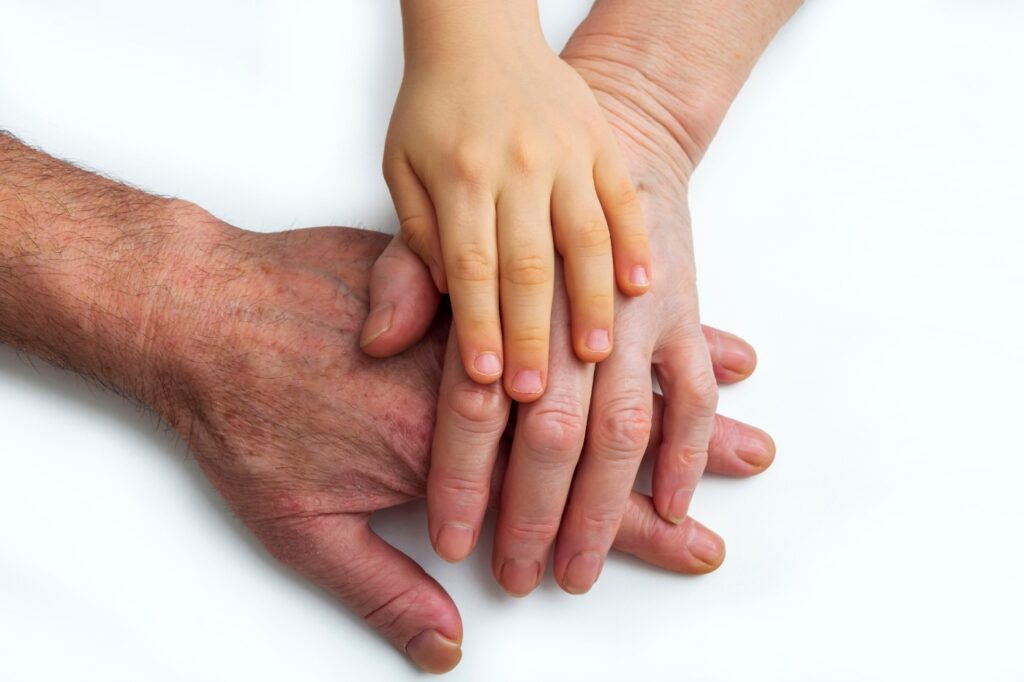
It’s National Grandparent’s Day! We love to talk about our grandchildren, show pictures and tout their accomplishments. And that’s because each one is special.
If you wonder why we care so deeply for our grandchildren, it all began a million years ago in the plains of Africa, writes geriatrician Dr. William Thomas in “What are Old People for? How Elders Will Save the World” (VanderWyk & Burnham, 2004). “A mother gave birth to a hominid child after a long and exhausting labor. She barely had enough energy to nurse her baby and not enough energy to feed or care for her other children.”
“A miracle occurred,” writes Thomas.
The maternal grandmother came to the rescue and intentionally shared her food with her grandchildren. It was a defining moment that created a new pattern of support that carried over to other families. Humans have the distinction of being the only species with grandparents who deliberately help raise their grandchildren.
There are at least two different stories about the origin of this holiday. Some consider Michael Goldgar as the initiator. He proposed National Grandparent’s Day after visiting his aunt in an Atlanta nursing home. After seven years, 17 trips to Washington, DC, and spending $11,000 of his own money, he continued to meet with legislators lobbying for the holiday.
The more well-known story is about Marian Lucille Herndon McQuade, a housewife in West Virginia who educated others about the important contributions of older adults as well as honoring lonely older nursing home residents. She urged people to adopt a grandparent not for just a day, but for a lifetime of experience.
Their efforts resulted in President Jimmy Carter passing a law in 1978 designating the first Sunday in September as National Grandparent’s Day.
We know grandparents are crazy about their grandchildren. And we know lots more. The latest census reports that there are 70 million grandparents. The average age of a first-time grandparent is age 50. Grandparents have on average four to five grandchildren and spend annually a collective $179 billion on their grandkids, according to new research from AARP. The average spent is $2,562 a year.
We often think of adult children supporting their aging parents. Although this is true in many cases, the reverse is also true. According to Lori Bitter, strategic consultant on older consumers, writes in her book “The Grandparent Economy: How Baby Boomers Are Bridging the Generation Gap” (Paramount Marketing Publishing, Inc., 2015), 52 percent of grandparents provide financial assistance to their grandchildren with about one third indicating that expenditure as having a negative impact on their own security. According to AARP, three-quarters spend about $800 on gifts for their grandchildren and a quarter spend $1746 on vacations. Here is the big one: 21 percent of grandparents spend, on average, $4,075 on school and college tuition. The list goes on with financial support for meals and groceries, allowances, rent, mortgages and medical costs.
Grandparents come to the rescue. According to a journal article in “Pediatrics,” nearly 3 million children in the United States are being raised by grandparents. Other data indicate about two percent of U.S. children are being raised by a grandparent with no parent in the household. These households are referred to as “grandfamilies.” Some of these children have faced traumatic events. In many cases, being raised by grandparents is a launch pad for success. Examples are presidents Barack Obama and Bill Clinton, comedians Carol Burnett and Jamie Foxx and musicians Eric Clapton and Willie Nelson.
The biggest barrier preventing grandparents from seeing their grandchildren has been Covid-19. Prior to the pandemic, it was distance. Over half of grandparents have at least one grandchild who lives more than 200 miles away and about a third live more than 50 miles from their closest grandchild. Another barrier is working grandparents which is about four in ten which is compounded by grandchildren’s busy schedules, according to Bitter.
Furthermore, Bitter reports that grandparents are philanthropic. In the U.S., they contribute $143.6 billion annually to charitable contributions which is 43 percent of all annual giving.
The purpose of Grandparent’s Day is well stated in the statute: “…to honor grandparents, to give grandparents an opportunity to show love for their children’s children and to help children become aware of the strength, information and guidance older people can offer.”
Related Articles
Exploring ways to identify ageism and counteract its negative effects
Ageism is about more than just hurt feelings
For Senior Citizen’s Day, ask what you can learn from an older person
How to get help for an aging family member when you live far away
Grandparents are an important influence – as guardians of family traditions, as unique friends to grandchildren, and as teachers and givers of gifts.
Let’s celebrate our beautiful treasures. Stay well and know that kindness is everything.
Helen Dennis is a nationally recognized leader on issues of aging and the new retirement with academic, corporate and nonprofit experience. Contact Helen with your questions and comments at [email protected]. Visit Helen at HelenMdennis.com and follow her on facebook.com/SuccessfulAgingCommunity
